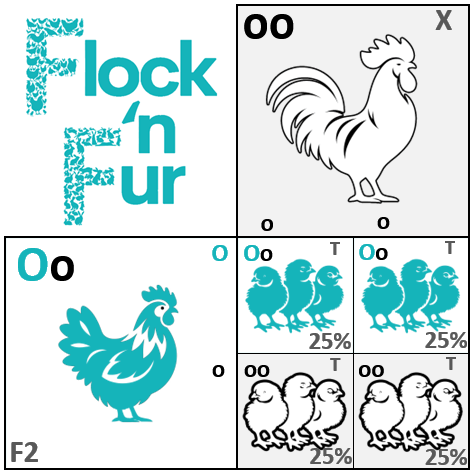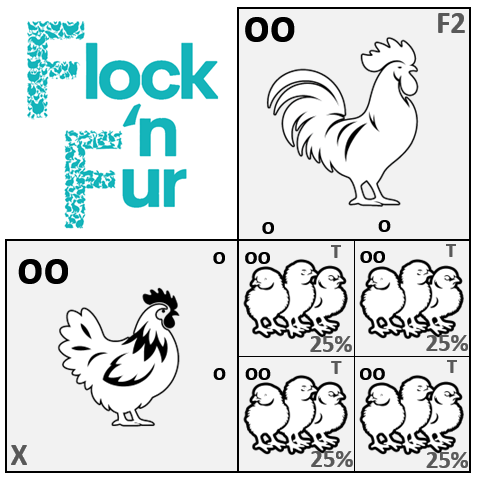Note that this is a subpart of the Breeding for the Blue Egg Gene article and is incomplete when read standalone.
To test by breeding, cross a selected F2 chicken with a breed possessing two white genes (no blue egg genes). This resulting offspring forms your test generation, existing solely for this purpose. Mark and track each test generation chicken back to its F2 parent. Raise only the hens of this test generation until you can determine their egg colour; the roosters are not required. Understanding the exact parentage of each hen is crucial. Breed and raise a sufficient number of your test generation from each F2 parent. Ideally, 50% of the hens from a parent with only one blue egg gene will lay white eggs, but this is simply a probability. To give you an idea of what should be a sufficient number, consider the typical % of offspring that are hens or roosters. Although theoretically, 50% of all offspring should be hens and 50% roosters, the reality often skews in one direction or another – sometimes even as drastically as one or two hens out of twelve. The same applies here; you may observe a skewed distribution towards either blue or white eggs. To avoid false positives, ensure you have enough offspring to confirm the presence of white-egg laying hens for F2 parents suspected of carrying just one copy of the blue egg gene.
Crossing your F2 chicken with a breed possessing two white genes will result in one of three outcomes, each of which will be demonstrated in Punnett squares. For illustration purposes, this chicken will be indicated with an ‘X’ in the Punnett square.
F2 Possessing one copy of each gene
F2 hen crossed with an X rooster, or F2 rooster crossed with an X hen: Even a single offspring hen that lays an egg with a white eggshell will indicate that the F2 parent possesses one copy of each gene (blue and white), indicating a heterozygous genotype. You can eliminate these F2 chickens from your breeding program.

50% of the offspring possessing two copies of the white egg gene.
Keys for this Punnett square:
‘O‘ represents the dominant gene for blue eggshells (oocyan).
‘o‘ represents the recessive gene for white eggshells.
‘oo‘: Possessing two copies of the white egg gene indicates a homozygous genotype for white eggshells.
‘Oo‘: Possessing one copy of each gene (blue and white) indicates a heterozygous genotype.
F2: Second generation cross.
X: Any chicken possessing the homozygous genotype for white eggshells
T: Test generation cross.
F2 possessing two copies of the white egg gene
F2 rooster crossed with an X hen. (You would already have eliminated these F2 hens based on their non-blue eggs.) When every single offspring hen lays an egg with a white eggshell, this indicates that the F2 parent possesses no copy of the blue egg gene, thus possessing two copies of the white egg gene, which indicates a homozygous genotype for white eggshells. You can eliminate these F2 chickens from your breeding program.

Keys for this Punnett square:
‘o‘ represents the recessive gene for white eggshells.
‘oo‘: Possessing two copies of the white egg gene indicates a homozygous genotype for white eggshells.
F2: Second generation cross.
X: Any chicken possessing the homozygous genotype for white eggshells
T: Test generation cross.
F2 possessing two copies of the blue egg gene
F2 hen crossed with an X rooster, or F2 rooster crossed with an X hen: When every single offspring hen lays an egg with a blue eggshell, this indicates that the F2 parent possesses two copies of the blue egg gene, which indicates a homozygous genotype for blue eggshells. These are the 25% that you wanted to identify and keep for further breeding purposes.

Keys for this Punnett square:
‘O‘ represents the dominant gene for blue eggshells (oocyan).
‘o‘ represents the recessive gene for white eggshells.
‘OO‘: Possessing two copies of the blue egg gene indicates a homozygous genotype for blue eggshells.
‘oo‘: Possessing two copies of the white egg gene indicates a homozygous genotype for white eggshells.
‘Oo‘: Possessing one copy of each gene (blue and white) indicates a heterozygous genotype.
F2: Second generation cross.
X: Any chicken possessing the homozygous genotype for white eggshells
T: Test generation cross.
